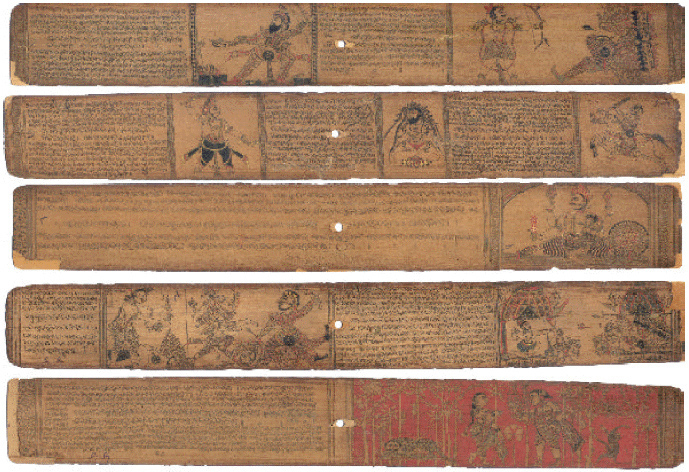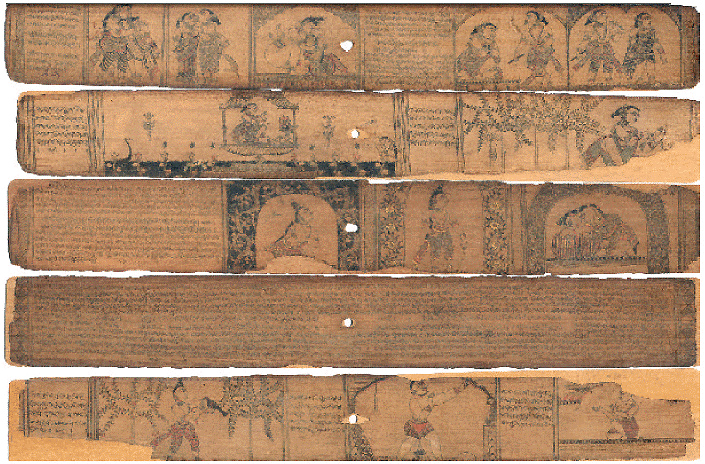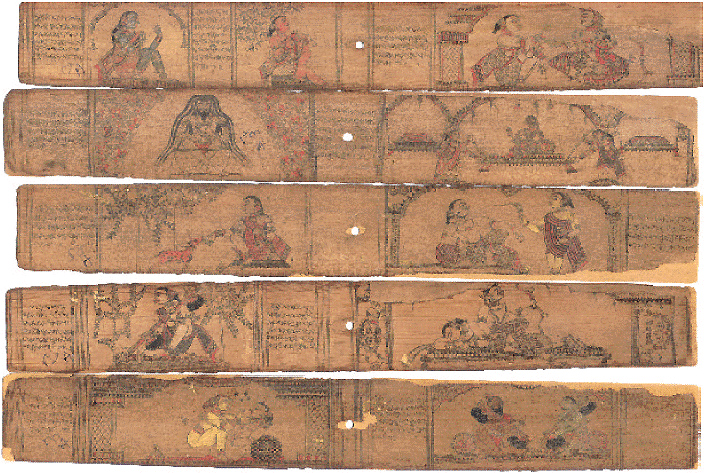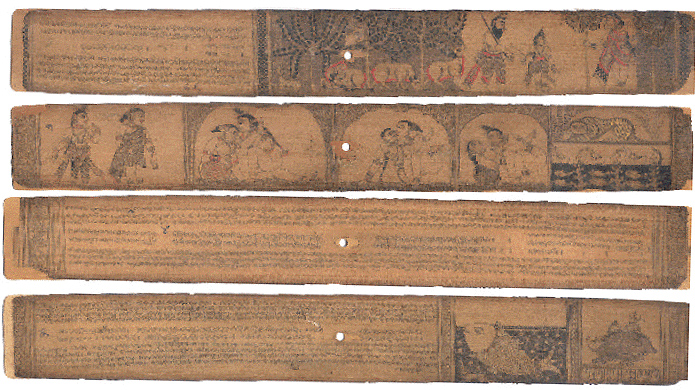Panoramic Palmleaf Manuscripts of Orissa
BY: SUN STAFF

Feb 7, BHUBANESWAR, ORISSA (SUN) — Illustrated palmleaf manuscripts in the collection of Orissa State Museum.
Orissa is exceedingly rich, since ancient times in exquisite and excellent palmleaf Manuscripts. These form an expanse of textual and illustrative eminence. The varied palmleaf manuscripts galore, now found in the collection of museums, private institutions and individuals, amply testify to the exuberance and efflorescence of this great tradition from about 10th Century A.D., as is evident from the epigraphic reference to Oriya language and Kutila script found in an inscribed sculpture of Jaina monk-Kumarasena, discovered from Gandhi-bedha in Balasore district. They formed the treasure house of wisdom and knowledge on different aspects of Orissan history, culture, artistic and architectural legacy.
Because of the easy availabilityof palmleaf in abundance in Orissa, the palmleaf manuscript culture became very popular through the ages. It also became easy to scribe and engrave different subject matters with an iron stylus. The Oriya, writing due to its round and linear shape, facilitated the growth and development of palmleaf manuscript writing and this tradition continues even to the present day.
Interestingly, the European scholars were greatly attracted to study the Oriya palmleaf manuscript collections during the nineteenth century. Rev J. Long published the first research article in the Journal of the Asiatic Society of Bengal and subsequently scholars like Col. Makenji, Sir John Beams, the then Collector of Balasore, R. L. Mitra, M. M. Chakravarti, H. P. Shastri and Prof. Macdonel, etc. contributed significantly to the study and research of palmleaf manuscript tradition of Orissa, which threw a flood of new light on the manifold aspects of variegated and glowing Orissan Culture.
After Orissa became a separate province in 1936, a series of serendipities and reconnaissance works were taken up to prepare a list of palmleaf manuscripts found preserved under different agencies through the help of local Pandits, and as many as 15 thousand titles were recorded out of which 11 thousand are now available in the Orissa State Museum. Education Department, Govt. of Orissa thereafter collected a large variety of palmleaf manuscripts with the initiative of Prof. G. S. Dash and Prof. N. Banerji, with the assistance of Prachi Samiti, under the banner of the newly founded Ravenshaw college Museum. Scholars like Padmasree Paramananda Acharya, Purna Chandra Rath and Kedarnath Mohapatra contributed enormously in their official and individual capacity to the enrichment of palmleaf manuscript collection.

When the Ravenshaw College Museum was shifted to Bhubaneswar during 1947- 48, Sri P. Acharya the then Superintendent of Orissa State Museum, and K. N. Mohapatra the, then curator of Manuscripts, opened a separate section of manuscripts in the Museum. This has now proliferated into an institution of international reputation with about 40 thousand manuscripts comprising 6 sections. Manuscripts have been classified under 27 subjects, namely:
1. Veda
2. Tantra
3. Jyotisha
4. Dharmasastra
5. Ayurveda
6. Ganita
7. Silpasastra
8. Samgita
9. Abhidhana
10. Vyakarana
11. Sanskrit Purana
12. Sanskrit Kavya
13. Alamkara
14. Bengali (Sanskrit)
15. Bengali
16. Devanagari
17. Oriya Purana
18. Oriya Kavya
19. Oriya Prose
20. Oriya Historical Literature
21. Sanskrit Paper Manuscripts
22. Oriya Paper Manuscripts
23. Arabic Manuscripts
24. Darsana Manuscripts
25. Telugu manuscripts
26. Copied Manuscripts
27. Illustrated Manuscripts
Simultaneously Sambalpur University, Berhampur University and Utkal University have opened their manuscript collections. Dr. N. K. Sahu organised a palmleaf manuscript section in Sambalpur. This has developed into a palmleaf manuscript library of Sambalpur University, which has in its collection manuscripts covering a wide range of subjects, including Veda, Grammer, Tantra, Astronomy, Medicine, Religion, Philosophy, Alankara, Epics, Puranas, etc.
Among these, the illustrated palmleaf of Bhagavata has evoked great interest from the scholars and Indologists of India and abroad. Berhampur University also has a rare collection of manuscripts including that of renowned poet Upendra Bhanja. Many private organisations like Raghunandan Library at Puri, Banchhanidhi Library, Nayagarh, Saintala College, District Bolangir and Veshja Patel College of Duduka, Sundargarh, Titilagarh College, Titilagarh, Individual collection of Sri Jitamitra Singh Deo, Khariar, Dileswar Patel of Kantapali, Dist. Jharsuguda, Dr. M. K. Misra of Kalahandi and Sri D.Pattnaik of Bhubaneswar have housed different varieties of palmleaf manuscripts.
In the arena of Indian philosophy, Oriya palmleaf manuscript writers have carved out a
permanent niche for themselves. Since the advent of Buddhism, philosophers like Dharmakirti, Kavidindima, Jivadevacharya, Acharya Narsimha Vajpeyi, Gaudiya philosopher Baldeva Vidyabhusan, Indrabhuti, Laxmikara etc. have contributed greatly in this field of study. Oriya dictionaries that were composed in Orissa, such as Trikanda Sesha and Haravali of Purusottama Dev and Medini Kosha of Medini Kara, have received wide recognition in India since early medieval times.
The Vedic manuscript collection of Orissa State Museum is not that large, because people are orthodox in nature and reluctant to part with their traditional individual collections. Even today, people of Orissa perform Vedic rites and rituals as per the diction of Vedic manuscripts. Therefore, unlike Bengal, Vedic palmleaf manuscripts are found in plenty in almost every Oriya house. Some manuscripts of Yajurveda and Atharvaveda have been brought from Midnapur district of West Bengal, Characters of these manuscripts are Oriya in content and nature which hints that originally they had been written by Oriya pandits and script writers. It is also a known fact that Midnapur region was part of Orissa till ancient times.
M. M. Shastri has mentioned the names of great Pandits like Jalesvara Misra, Bhaskara Parivrajaka and Haladhara who wrote valuable commentaries on the Vedic works. Late Pandit D. N. Bhattacharya, an erudite scholar of Bengal, was fortunate to get a complete manuscript of the Paippalada Sakha of the Atharva Veda from Jagannathpur in the District of Puri, which was not available in any other part of India. A few kandas of this unique Vedic work have been published so far. There are a number of these manuscripts in our collection containing different archas (chapters).
There are three manuscripts containing Sayana’s Bhasya on the Kanvasamhita, of which one is complete in twenty-one chapters of its second part of Bhasya. Our collection is not enriched by the acquisition of the manuscripts of different Brahmanas of the Yajurveda Upanisads, Tapinis and Angirasakalpa of the Atharavaveda, some of which are as yet unknown to the scholars.
Orissa was a popular centre of Tantric cult from 6th century A.D. Baladeva Rath and Gaurahari Parichha, etc. contributed enormously to the Oriya literary exuberance of this epoch. Their activities inspired a number of followers to compose more creative compositions in the field of art and literature. They are Pitambar Deva’s Akhila
Ratha Chintamani, Kesava Ratha’s Ananga Ragini, Anuraga kalpalata of Shyamasundar Deva, Haravati of Ramachndra Pattnaik, Anuragavati of Padmanabha, etc. In addition to these we find a number of lesser known writers like Madhavi Dasi, Rani Mohan Kumari, Rani Kshirod Mali, Krishnapriya Jema, Sivapriya Dei, Kalpalata Jema, Madhuri Dasi, Achuta Jema and host of others. We find a good number of palmleaf manuscripts of historical prose and translation works. Oriya scholars have also contributed to Bengali and Hindi manuscript composition. Among the Bengali works to have been composed by Oriya poets are Krishnalila of Ramachandra Pattanaik, Manasamangal of Dwarika Dasa, Govardhan Utsava of Gourachandra Parichha, Basanta Rasa of Pindika Srichandan, Dolarasa of Natabar Dasa, Navanuraga of Shyamabandhu Pattnaik, and Ganga Mahatmya of Jagannath Dasa.
In Hindi we find literary works Brajaboli gita of Ramananda Patnaik, Jayachandrika and Kosalananda of Prahallad Dube, Gundicha Vije of Brajanath and poems of many other poets. Besides we also find palmleaf manuscripts written in Telugu, Tamili, Sarada, Newari, Persian and Urdu. The manuscript gallery of Orissa State Museum is now adorned with such a rare palmleaf manuscripts collection.
Sarala Dasa, the writer of Mahabharat in Oriya, has contributed a number of works of eminence like Saptakanda Ramayana, Chandi Purana, Valmiki Ramayana, Malasri Janana and Mahalaxmi Vrata, etc. These manuscripts are now found in the collection of the State Museum. He established Oriya as a rich language in the 15th century A.D. Mahabharata of Krishna Singh, Purusottam Dasa, Jagannath Das and Kapileswar Nanda are also some of the prize collections of the manuscript section. Mahabharata and Ramayana became very popular in Orissa, as they were written in Oriya languages and script due to the initiative of Balaram Dasa, Maheswar Dasa, Kirshna Chandra Rajendra, Kesava Tripathi and Purusottam Dasa. The Madala Panji, the temple chronicle of Puri written in palmleaf is a storehouse of knowledge that needs a thorough and separate study.
Bhagavata Purana was translated by Jagannath Das and has become the Bible of Oriya people. He completed this work in the Jagannath temple before the advent of Sree Chaitanya in Puri. His mastery over Sanskrit literature enabled him to translate this work into a very lucid and simple style. We have several copies of this masterly work in our collection. The works Bhagavata Lahari, Harivamsa, Padmapurana by Achyutananda and the works of Mahadeva Dasa, Haladhara Dasa, Nilambara Dasa, Pitambara Dasa are also a few unique acquisitions of the section.

Few poetic compositions have historical value like Jagannath Charitamruta, Chaitanya Charitamruta and Bhaktamala, Copies of Veda, Tantra, Dharmashastra, Jyotisha, Vyakarana, Kavya, Alankara etc. have enriched the manuscript legacy of Orissa. They have been written in Sanskrit language with provincial Oriya script. A few notable works in these fields are mentioned below for reference of researchers and tourists:
1.Vedartha Praveshatika or Sayana Bhashya of Yajurveda, 2.Paippalada Samhita of Atharvaveda, 3.Brahmanas according to Kanva Sakha or Yajurveda, 4.Jnanavalli Tantra, 5.Durga Janana Dipika, 6.Bhubaneswari Prakasa, 7.Tarini Kulasudha Tarangini, 8.Bhasvati, 9.Kritya Kaumudi, 10.Vaisvanaresti Paddhati, 11.Vidyakara Padhati,12.Nityacharadipa, 13.Vaijalakarika, 14.Prakriyasara, 15.Sarasidhanta Samagraha, 16.Anyopadesasataka,17.Abdaduta, 18.Gitagovinda, 19.Gundicha Champu, 20.Bhakti Bhagavatamahakavyam, 21.Bharatamrita Mahakavyam, 22.Manimala Natika, 23.Rukmini Parinaya, 24.Raghavayadaviyamahakavya, 25.Kavya Prakasa Vivarana, 26.Sahityabhusana, 27.Gita prakasa, 28.Sangitanarayana, 29.Sangitakalpalata.
Charles Fabri remarks that those who carved the masterpieces of sculpture in the 9th, 10th and 11th century A.D. must have also been able to carve lovely pictures on their palmleaf manuscripts. Unfortunately we do not find any specimens prior to the 15th century A.D. As palmleaf manuscripts are perishable, the earlier paintings and engravings must have been obliterated. However, we find lively specimen from 15th century A.D. onwards, as reported by Prof. Ganguly. Thus the history of the incised drawings on palmleaf manuscripts goes back to a definite datum line. Differences between stylus incised line drawings and coloured paintings are enormous. They seem to belong to two worlds, even if one recognizes the elements of hieratic drawings, the ready-made formula for eyes, hands, lips etc. of the line drawings being re-employed as a basis for paintings. He has referred to the live leaves of a palmleaf manuscript by one Lokanath Dasa now found in the Raghunandan Library, Puri. They are illustrations of Ushaparinaya text and their date has been assigned to the 18th century.
In the painting, women don’t put on blouses except the end of the saree draped over their breast. There is one complete naked woman in leaf-4 from the top left side and she is draped under an element whom she appears to embrace. Such erotic illustrations we find in other private collections also. In Ushaparinaya compositions, male figures are found wearing typical Mughul tang paijama, i.e., tight fitting leggings. In another illustration we find 4 palmleaves from a Ramayana manuscript in the collection of Sadasiva Rath Sharma. All the men were found wearing tight Mughul trousers and belted coats, and Marathi turbans. The females wear blouses and saree. Sita seems to have put on a ghaghara, choli, orni that is skirt blouse and headkerchief.
The Orissa State Museum has obtained a good collection of such illustrated manuscripts some of which are in display. The subjects are mostly derived from Ramayana, Mahabharata and Bhagabata Purana. In many cases temple styles, gods and goddlings are also found. The most interesting is one Kandarpa Ratha, illustrated over a bunch of palmleaves cut to size and stitched together horizontally in a rectangular shape. Enchanting and impressive maidens are intricately arranged to form the chariot, with Radha and Krishna in embrace placed at the centre. Another most important treasure of the section is the Gita Govinda. The plates are palmleaf size and every plate contains about 17 lines on each side.
We also find musical texts in palmleaf manuscripts. The Oriya poets have experimented with the use of music in a traditional Sanskrit lyric. This indicates that music was prevalent in the country prior to Jayadeva. From the style of collection of this text, it is believed that Southern Orissa and Puri were the main centres of this musical culture, where regular musical performance along with textual discussions were being held. From the days of Bharatmuni, Orissa had a special style of music. The Natya Shastra of Bharat has given special importance to the Udra style of music. It is an irony that old Sanskrit scripts dealing with music are not available in Orissa. Such texts generally belong to late medieval times. They include Samgita Kaumodi, Gitaprakash, Samgita Kalpalata, Samgita Narayana and Natyamanorama etc.
Orissa, the land of temples and shrines, has also received the prolific impress of palmleaf manuscript art diction. However, few texts are now available, among which Bhuvanpradipa occupies a conspicuous position. N. K. Bose refers to some of the palmleaf manuscripts and says that they are written with an iron stylus. In the Bhuvana-pradipa we find description of temples, altars, and similar structure. There is no reference to secular architecture. Hence the word Bhubanapradipa may be taken to mean the lamp which sheds light on the characteristics of the abode of the Gods.
We do not find names of artists who constructed the colossal temples of Bhubaneswar, Puri and Konark, but in the Bhuvanapradipa there is reference to Pingla, the artist and Ahidhar the carpenter, along with information regarding parting dues of each functionary at the end of the ceremony of the construction of the temple, which reads that the Brahmin who will perform Japa will get his dues equivalent to the astrologer.
Many manuscripts are found uncared for in the villages, which are in a state of decay and destruction. They are the depository of our cultural heritage and should be restored by popular drive through various institutions and individuals dedicated to the cause of saving the extinct palmleaf manuscript heritage of Orissa.
The precious palmleaf manuscripts of the Museum deserve special mention. It is ascertained from records that 37,273 manuscripts have been collected out of which fifty two manuscripts have been published. Ten descriptive catalogues of manuscripts, five alphabetical catalogues and one alphabetical catalogue of authors have been made. The manuscript section comprises twenty-seven sections such as Veda, Tantra, Darsana, Historical records, Silpa Sastra, Abhidhana, Ayurveda, etc. It has Palmleaf, Bamboo leaf, Handmade paper, Old paper, Ivory manuscripts, Bhurja bark, Manuscript, Kumbhi bark manuscripts, Garland shaped, Fan shaped, Fish shaped, Sword shaped, Rat and Parrot shaped varieties of manuscripts, and different types of stylus are displayed in the section.
Three hundred sixty six illustrated manuscripts of coloured and monochrome variety are found. Important variety such as manuscripts of Gita Govinda of Kali Charan Pattnaik, the Usha harana, Ushavilasa, etc. and different varieties of cover design of palmleaf manuscripts are in the collection. As many as seven thousand manuscripts have been conserved scientifically and manually by way of dry and wet cleaning, filling of holes made by worms, use of preservative chemicals and reinking of invisible writing of manuscripts. A microfilming unit has been functioning in this section since 1985-86 thanks to the donation of Ford Foundation. One thousand seven hundred ninety-eight palmleaf manuscripts have been microfilmed up to date. It is worth mentioning that even today, palmleafs are used for recording horoscope (Jataka) of newborn babies. For invitation to God, it is also used. In 15th century A.D. the palmleaf tradition reached a pinnacle of excellence, with wide distribution.

Etching and painting on palmleafs is a very ancient art diction of Orissa. Origin of this art form marked the beginning of dissemination of written version. It is, therefore, part of our literary tradition. With the munificence of Orissan rulers, illustrated manuscripts reached a climax of excellence, vindicating the ancient nomenclature of Utkal, i.e., “land of art of exuberance and efflorescence’. Even to this day, the glorious tradition thrives in the work of handicraft artisans of Orissa. The art form comprises inscribed letters and paintings of various designs. Such a piece of work is a befitting item for presentation as a memento or souvenir.
It is heartening that the Government of India have recently launched National Mission for Manuscripts, for documentation, preservation and dissemination of the manuscript heritage of the country. In Orissa in this Project up till now, more than eighty thousand manuscripts have been documented and disseminated in addition to the 40,000 collection of Orissa State Museum.
The National Mission for Manuscripts seeks to develop a holistic approach in locating, documenting, protecting and making accessible the significant information of the manuscript heritage of India. This challenging task is carried out through wide networking with institutions and scholars across the country and abroad who have manuscript holdings and interest in their preservation. The NMM has identified some of the most prominent institutions across the country with considerable manuscript holdings and has designated them as Manuscript Resource Centres (MRC). Indira Gandhi National Centre for Arts, New Delhi, has been identified as the National Nodal Agency and Orissa State Museum, Bhubaneswar has been designated as the MRC to carry out the survey and listing work of manuscripts in Orissa.
Dr. C. B. Patel, Superintendent of Orissa State Museum has been designated as Project Co-ordinator. Orissa Art Conservation Centre, and Orissa State Museum has been identified as the Manuscript Conservation Centre for Orissa. Keeping in view the above, MRC/OSM is organizing different Awareness Campaigns, workshops to popularise the mission work and to document manuscripts. Donations from individuals and institutions are accepted free of cost for organisation of Central Manuscript Library by NMM at IGNCA, New Delhi. An extensive five day sample survey of palmleaf manuscripts in all the thirty districts of Orissa is already on the anvil. It is hoped, on completion, the National project will open many new avenues of exuberant Orissan palmleaf tradition, idiom and diction.
